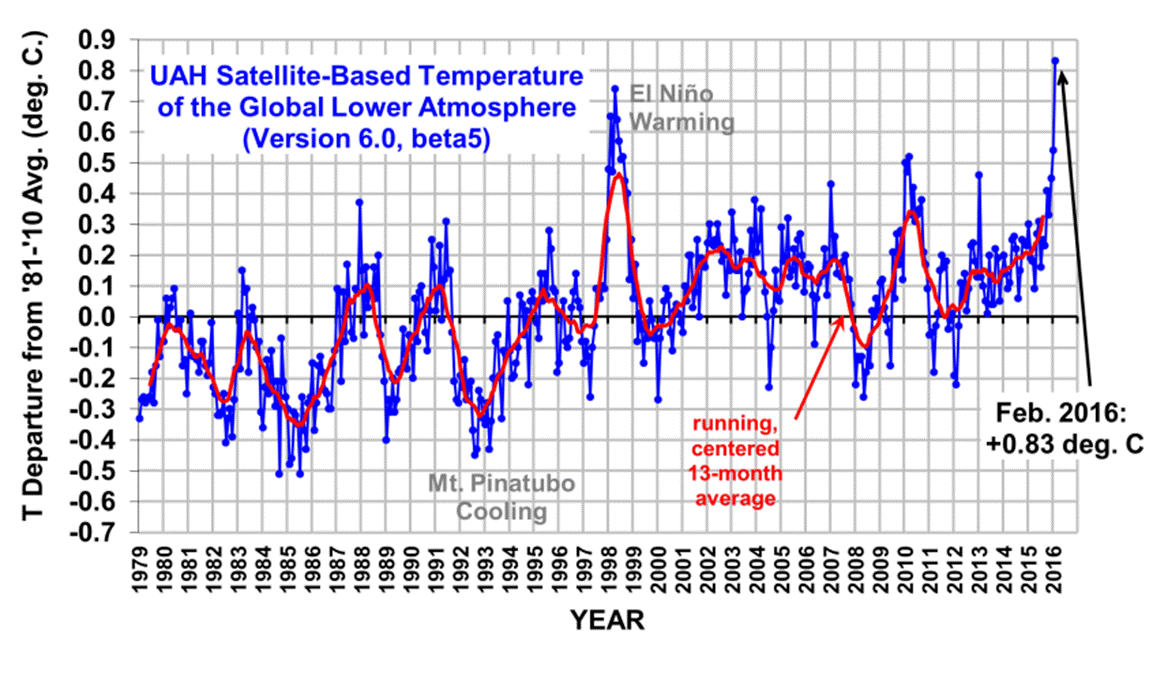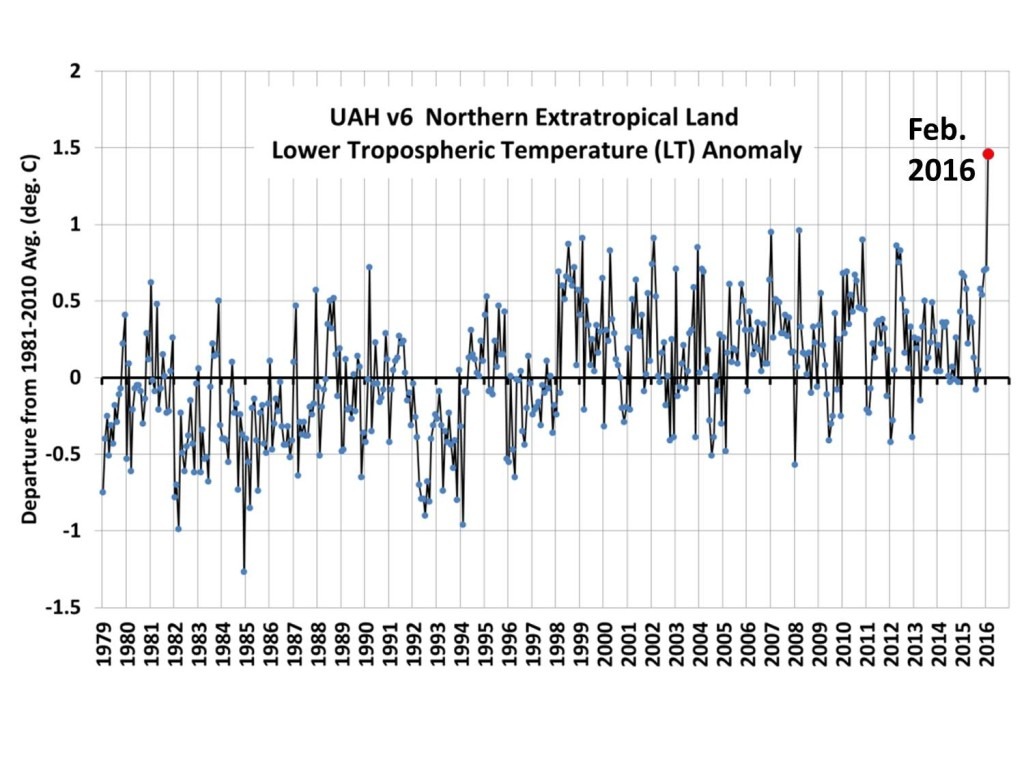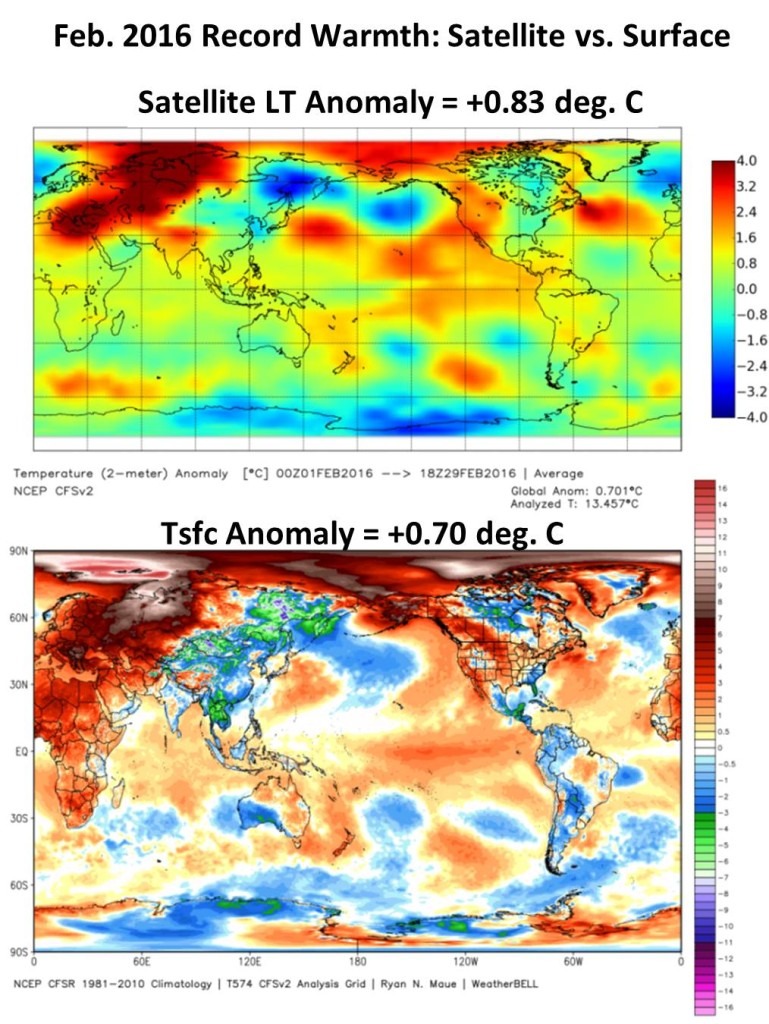NOTE: This is the eleventh monthly update with our new Version 6.0 dataset. Differences versus the old Version 5.6 dataset are discussed here. Note we are now at “beta5” for Version 6 (hopefully the last beta before submission of the methodology for publication), discussed more below.
The Version 6.0 global average lower tropospheric temperature (LT) anomaly for February, 2016 is +0.83 deg. C, up almost 0.3 deg C from the January value of +0.54 deg. C (click for full size version), which is a new record for the warmest monthly anomaly since satellite monitoring began in late 1978. (If clicking on the image leads to an error, this is due to “caching issues” according to my new website hosting company…I don’t know how to fix it.)
The global, hemispheric, and tropical LT anomalies from the 30-year (1981-2010) average for the last 14 months are:
YR MO GLOBE NH SH TROPICS
2015 01 +0.30 +0.44 +0.15 +0.13
2015 02 +0.19 +0.34 +0.04 -0.07
2015 03 +0.18 +0.28 +0.07 +0.04
2015 04 +0.09 +0.19 -0.01 +0.08
2015 05 +0.27 +0.34 +0.20 +0.27
2015 06 +0.31 +0.38 +0.25 +0.46
2015 07 +0.16 +0.29 +0.03 +0.48
2015 08 +0.25 +0.20 +0.30 +0.53
2015 09 +0.23 +0.30 +0.16 +0.55
2015 10 +0.41 +0.63 +0.20 +0.53
2015 11 +0.33 +0.44 +0.22 +0.52
2015 12 +0.45 +0.53 +0.37 +0.61
2016 01 +0.54 +0.69 +0.39 +0.85
2016 02 +0.83 +1.17 +0.50 +0.99
Further Analysis of the Record February Warmth
The 1-month increase of +0.29 C in global average temperature from January to February is not unprecedented…for example, during the last El Nino (2009-10) there was +0.38 C warming from December to January.
The February warmth is likely being dominated by the warm El Nino conditions, which tends to have peak warmth in the troposphere close to February…but it appears that isn’t the whole story, since the tropical anomaly for February 2016 (+0.99 C) is still about 0.3 C below the February 1998 value during the super-El Nino of that year. In addition to the expected tropical warmth, scattered regional warmth outside the tropics led to a record warm value for extratropical Northern Hemispheric land areas, with a whopping +1.46 C anomaly in February…fully 0.5 deg. C above any previous monthly anomaly (!):
As a sanity check on the latest data, I compared our monthly anomalies to the 2m surface temperatures analysed from the NCEP CFSv2 by Ryan Maue at WeatherBell.com. His calculated global average anomalies (from the 1981-2010 mean) for January and February 2016 were +0.51 and +0.70 C, respectively, which is close to our +0.54 and +0.83 C values (some amplification of tropospheric anomalies vs. surface is always seen during El Nino). Here are the regional temperature anomaly patterns for February in the two datasets:
Even though the CFSv2 surface temperature analysis in the above plot is not “official”, I think it is a pretty good representation of what really happened last month, since it includes all sources of data in a physically consistent way within the daily weather forecast model framework. Note that on a monthly time scale we do not expect perfect correspondence between surface temperature and deep-tropospheric temperature anomaly patterns…especially in the deep tropics; the agreement in regional patterns seen above is about as good as it gets.
The “official” UAH global image for February, 2016 should be available in the next several days here.
The new Version 6 files (use the ones labeled “beta5”) should be updated soon, and are located here:
Lower Troposphere: http://vortex.nsstc.uah.edu/data/msu/v6.0beta/tlt
Mid-Troposphere: http://vortex.nsstc.uah.edu/data/msu/v6.0beta/tmt
Tropopause: http://vortex.nsstc.uah.edu/data/msu/v6.0beta/ttp
Lower Stratosphere: http://vortex.nsstc.uah.edu/data/msu/v6.0beta/tls

 Home/Blog
Home/Blog






